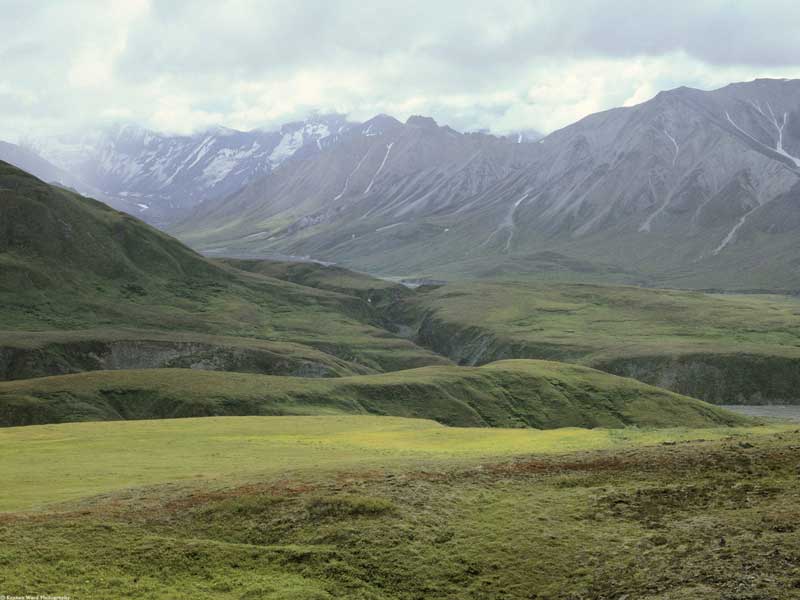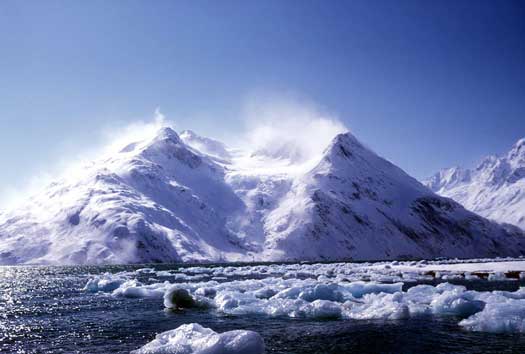The Brooks Range in the Arctic National Wildlife Refuge: ‘It was like a time machine had taken me back to the beginning of the world.’‘The Sky Was Like Another Ocean. The Nearby Mountains Were Ruins Left Over From The Ice Age.’
Dr. Douglas Brinkley goes to Washington to urge the Arctic National Wildlife Refuge be named a National Monument in honor of Pres. Dwight D. Eisenhower, who created it.
Dr. Douglas Brinkley, a history professor at Rice University in Houston is also America’s preeminent Presidential historian and an eloquent defender of the environment and wilderness areas in general. He has been in the forefront of efforts to protect Alaska’s wilderness areas from exploitation and destruction by oil and gas interests. An advocate for designating the Arctic National Wildlife Refuge (ANWR, a roadless, unbroken expanse the size of South Carolina that is the largest of the more than 500 refuges in America’s national wildlife refuge system) a national monument to protect it from oil and gas drilling, Dr. Brinkley has written a book, The Quiet World, about the history of and efforts to protect the Alaskan wilderness, and another, Wilderness Warrior, about Theodore Roosevelt’s environmental policies.
On November 18, Dr. Brinkley testified before the U.S. House Natural Resources Committee. The committee was taking testimony on another congressional effort to open the Arctic National Wildlife Refuge (ANWR) to oil exploration and drilling, and Dr. Brinkley was there to press the point about giving ANWR national monument status. His testimony generated national headlines--not for the content of his remarks but for a heated exchange he had with Rep. Don Young (R-Alaska), a fervent anti-environmentalist (he has called environmentalists “a self-centered bunch of waffle-stomping, Harvard-graduating, intellectual idiots”), who walked into the meeting late, then addressed Dr. Brinkley as “Dr. Rice” and referred to part of his testimony as “garbage.” Refusing to be cowed by a cheap thug, Dr. Brinkley fired back, "It’s Doctor Brinkley. Rice is a university. I know you went to Yuba College and didn’t graduate." To which Rep. Young responded: "You just be quiet!"
The Nov. 18 exchange between Dr. Douglas Brinkley and Rep. Don Young before the U.S. House Natural Resources Committee.Rep. Young is a national disgrace who should be “boiled in his own pudding,” as Dickens would say. Dr. Brinkley, on the other hand, was met with applause from his students when he returned to his classroom at Rice, and from other supporters far and wide. "I have received now hundreds of hundreds of emails from people all over," Dr. Brinkley said. "I haven’t received one negative one. I’ve had the entire Rice University and including Texas conservatives cheering me on for standing up to his bullying tactics. I wasn’t looking forward to some kind of conflict of any kind. But, these things confront you (in life). It hit me. I responded and I don’t retract anything. I’m very glad I held him accountable."
So that Dr. Brinkley’s appearance before Congress is remembered for more than his testy exchange with an ignorant Congressman, this month’s Nature’s Temple offers the complete text of his testimony and a big thumbs up for his proposal to designate ANWR a national monument. It would be a wonderful Christmas present the Obama administration could give the country.
***
Dr. Douglas Brinkley during his Nov. 18 testimony before the the U.S. House Natural Resources Committee.No picture book can do justice to the ethereal beauty of the Arctic National Wildlife Refuge (ANWR). I camped there in the summer of 2010 along the Hulahula River. The sky was like another ocean. The nearby mountains were ruins left over from the Ice Age. One afternoon in the Arctic I saw a grizzly climbing up a hill, running at tremendous speed. It was like a time machine had taken me back to the beginning of the world. Everything from the caribou herds to the wildflowers was primordial, uncontaminated, and fresh. Back in 1960 President Dwight D. Eisenhower was a true visionary when he created the Arctic Refuge. To Eisenhower, and his Interior Secretary Fred Seaton, Arctic Alaska—like Antarctica—was too precious a wilderness heirloom to permit destructive oil, gas, military, and mining activity. By saving this remote part of Arctic Alaska, Eisenhower earned his gold-starred place as one of America’s great conservation presidents.
ANWR oil drilling has been a controversial topic in the news. Explore Alaska's Arctic National Wildlife Refuge one day after the summer solstice with photographer and reporter, Jim Lo Scalzo. Join him as he hikes along the arctic tundra and its landscapes under the never-setting sun to see his personal side of the ANWR oil drilling controversy.To Eisenhower there were some natural places that defined what it meant to be American; the ANWR wilderness in northeastern Alaska is one of those sacred spots. Fifty years ago, our parents’ and grandparents’ generation—in the Eisenhower era—looked out across Alaska’s North Slope wilderness and decided to set the Arctic Refuge aside as protected sanctuary for the abundant wildlife that depended on it. It rapidly became spiritual grounds where U.S. soldiers returned from overseas combat to heal. Outdoorspersons from all over the world come to Arctic Alaska to hunt, fish, and clear their minds from the white noise of hyper-industrialization. Congress, in my opinion, has a moral responsibility to help save Eisenhower’s Arctic sanctuary—a wonder like Yellowstone, the Tetons, Big Bend, and the Grand Canyon—for future generations to enjoy.
Last year ANWR celebrated its 50th anniversary as America’s premier refuge. But virtually nothing was done to commemorate Eisenhower for his incredible conservation accomplishment as its brave founder. The U.S. Interior Department now has an opportunity to rectify this omission, to honor our 34th president for his extraordinary environmental foresight. Congress should urge President Obama to use the Antiquities Act of 1906 to permanently establish the Eisenhower National Monument out of Section1002 land within ANWR. The Coastal Plain along the Beaufort Sea is the most important denning habitat for U.S. polar bears in the Arctic Alaska. It is also an essential habitat for wolves, grizzly, and brown bears. Over 130 bird species rely on the coastline, lakes, and rivers of ANWR for nesting, feeding, and breeding. Throughout the course of a year, at least one avian species from every state (except Hawaii) makes its way to ANWR. Birders from all of the country track the migratory patterns of birds like mallards, tundra swans, red-throated loons, snow geese, and northern pintail ducks on their way to the Arctic. Any loss of habitat in this region will necessarily result in a corresponding loss of opportunities for bird watching and hunting. The Eisenhower National Monument would secure lasting protection for the Coastal Plain’s terrestrial and marine wildlife. There are those in the U.S. Congress who believe the Coastal Plain of ANWR should be leased to foreign oil companies like British Petroleum and Royal Dutch Shell. I believe it should remain an unmolested U.S. wilderness sanctuary, public land used for outdoors recreation by world citizens.
The Arctic National Wildlife Refuge: a 50th anniversary video tributeAs a former director of the Eisenhower Center, World War II scholar, and lover of Wild America, I think it’s important that our nation honor conservation heroes. By commending the life and legacy of Eisenhower, declaring the 1002 area of ANWR the Eisenhower National Monument—via executive order—the Obama administration would be preserving one of America’s wildest landscapes and honoring the great Supreme Allied Commander of the Second World War who was responsible for Alaskan statehood. Re-designating the Coastal Plain—the “biological heart” of ANWR—is the proper way to nationally honor Eisenhower with something more meaningful than Interstate Highway signs and a parkway in New Jersey.
As president of the United States, Eisenhower pushed for world peace and conservation in a number of imaginative ways. It is Eisenhower who spearheaded the successful global campaign to prohibit military bases, military exercises, and weapons testing in Antarctica. Today the majestic mountains that rise between Reeves Neve on the west, Reeves Glacier on the south, and Priestley Glacier on the north and east in Victoria Land, Antarctica are officially known as the Eisenhower Range.
Life in the Arctic National Wildlife Refuge. Part 1 of a video chronicle documenting the lives of Heimo and Edna Korth, who live in the Arctic National Wildlife Refuge, 150 miles above the Arctic Circle. ‘Eventually they just want to get people out of the land here,’ Heimo says. ‘That’s why this permit for us to be here is only good up until the death of our last child. Then after that, that’s it.’This is part 1 of a five-part documentary. For the other installments, visit the Far Out YouTube page.If Antarctica can honor Eisenhower’s conservation legacy with a range, surely the United States can do the same in Arctic Alaska. There are those that argue Section 1002 should be designated Wilderness by Congress. I believe that process is too time consuming and slow. Alaska has already been harder hit by global warming than any other part of the nation. The state’s average temperature has risen 4 degrees Fahrenheit in the past fifty years, and there have been major reductions in populations of coastal and marine bird species, seals, and sea lions. President George W. Bush rightfully used the Antiquities Act in 2006 to designate 195,000 square miles of the Pacific Ocean as the Northwestern Hawaiian Islands Marine National Monument when he thought that ecosystem was in peril. President Obama could become a conservation hero for doing the same for Section 1002 of Arctic Alaska.
Let history show that Congresspersons on November 18, 2011—recognizing the need to honor Eisenhower, protect a world-class landscape, and address the global climate crisis—urged the White House to add an additional layer of federal protection in Arctic Alaska. I look forward some day to camping with my wife and three children in the Eisenhower National Monument—a far better name than Section 1002—as the premier attraction in ANWR.
Harriman Fjord, Arctic National Wildlife Refuge (Photo: USFWS/Emily Dickinson’s Nature Mysticism)
Founder/Publisher/Editor: David McGee
Contributing Editors: Billy Altman, Laura Fissinger, Christopher Hill, Derk Richardson
Logo Design: John Mendelsohn (www.johnmendelsohn.com)
Website Design: Kieran McGee (www.kieranmcgee.com)
Staff Photographers: Audrey Harrod (Louisville, KY; www.flickr.com/audreyharrod), Alicia Zappier (New York)
E-mail: thebluegrassspecial@gmail.com
Mailing Address: David McGee, 201 W. 85 St.—5B, New York, NY 10024





